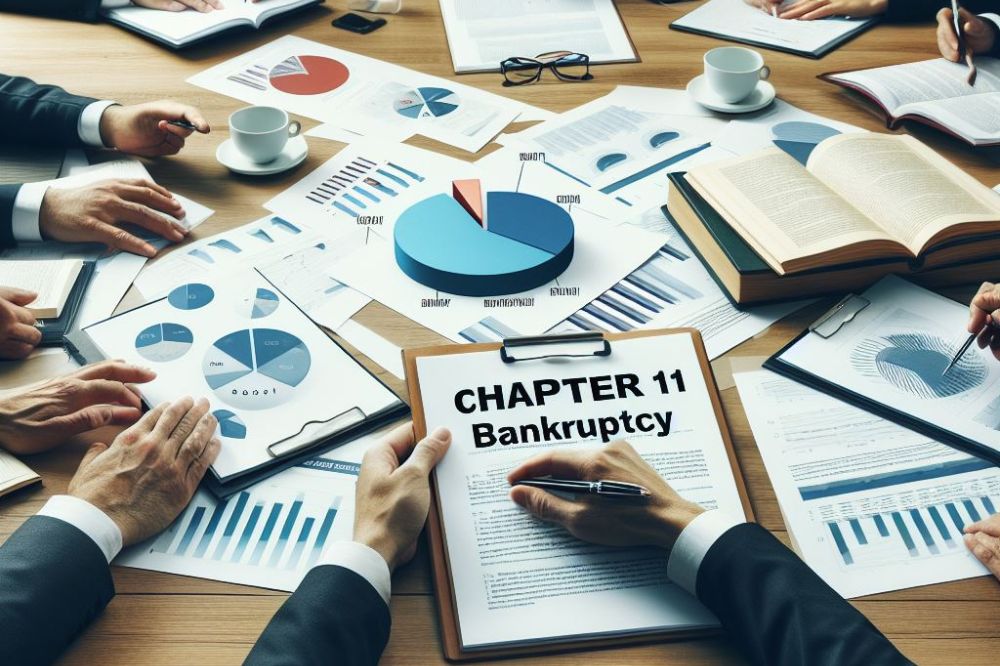Navigating business reorganization during bankruptcy can be a challenging yet essential process for companies facing financial turmoil. While bankruptcy signifies financial distress and business failure, it also offers opportunities for restructuring and revitalizing operations. Companies must carefully strategize to emerge stronger post-bankruptcy, safeguarding their future viability. Understanding the complexities of business reorganization during bankruptcy is crucial for making informed decisions that can shape the company’s trajectory.
Key Takeaways
- Understanding Bankruptcy: Familiarize yourself with the different types of bankruptcy to determine the most suitable option for your business.
- Planning for Reorganization: Develop a comprehensive reorganization strategy that aligns with your business goals and financial situation.
- Protecting the Business: Safeguard your assets and operations by understanding the legal protections available during bankruptcy proceedings.
- Engaging with Creditors: Establish open communication with creditors to negotiate repayment terms and seek mutually beneficial solutions.
- The Reorganization Plan: Craft a detailed reorganization plan outlining how the business will operate post-bankruptcy to regain stability.
- Implementing the Plan: Execute the reorganization plan effectively, making necessary adjustments along the way to ensure its success.
Understanding Bankruptcy
Chapter 11 Basics
Chapter 11 bankruptcy provides businesses with a chance to restructure their debts and operations. This chapter aims to help companies regain financial stability by creating a repayment plan. The key features of Chapter 11 include the ability to continue business operations while restructuring debts, negotiating with creditors, and proposing a reorganization plan.
Filing for Chapter 11 offers advantages such as the opportunity to stay in business, protect assets from creditors, and have more control over the restructuring process. However, there are also disadvantages like high costs, public scrutiny, and the complexity of the legal procedures involved.
Bankruptcy Process
The bankruptcy process typically involves several steps starting with the filing of a petition in court. Once filed, an automatic stay goes into effect, halting creditor collection activities. The bankruptcy court oversees the proceedings to ensure compliance with laws and regulations. It is crucial for businesses to adhere strictly to these guidelines throughout the process.
Compliance with bankruptcy laws is essential as any violations can lead to severe consequences such as dismissal of the case or even criminal charges. Therefore, it is imperative for debtors undergoing bankruptcy to work closely with legal professionals who specialize in this area.
Debtor in Possession
A debtor in possession takes on the responsibilities of managing the business during bankruptcy proceedings. They have the authority to make operational decisions, negotiate contracts, and oversee day-to-day operations. This role is crucial as it allows the business to continue operating under supervision while working towards financial recovery.
The debtor in possession plays a vital role in formulating and implementing a reorganization plan that addresses debt repayment and operational restructuring. Their decisions impact the outcome of the bankruptcy process significantly and can determine the future viability of the business.
Role of U.S. Trustee
The U.S. Trustee serves as a watchdog in bankruptcy cases, ensuring that all parties comply with laws and regulations. They monitor financial disclosures, investigate misconduct or fraud, and oversee creditors’ committees. By maintaining transparency and accountability throughout the process, the U.S. Trustee helps uphold the integrity of the bankruptcy system.
Planning for Reorganization
Filing Requirements
Filing for bankruptcy involves specific documents and forms, such as schedules of assets and liabilities. Meeting eligibility criteria is crucial, including credit counseling completion. Accuracy and timeliness in meeting filing requirements are essential to avoid delays.
Small Business Considerations
Case specifics
Understanding the unique details of each bankruptcy case is vital for a successful reorganization. Case specifics, such as types of debts and assets, heavily influence the restructuring process. Tailored strategies are crafted based on these specifics to maximize outcomes.
Debt limits
Chapter 11 bankruptcy imposes debt limits to qualify for reorganization. Exceeding or falling below these limits can impact eligibility significantly. Understanding how debt limits affect the bankruptcy process is crucial for small businesses navigating financial challenges.
Real Estate Debtor Issues
Addressing real estate debtor issues in bankruptcy requires a deep understanding of how real estate assets are treated during reorganization. Challenges like property valuation and mortgage obligations must be carefully managed. Despite challenges, bankruptcy also presents opportunities for real estate debtors to restructure effectively.
Protecting the Business
Automatic Stay Explained
The automatic stay is a crucial component of bankruptcy, immediately halting all creditor actions against the debtor. It provides breathing room for the struggling business to reorganize without constant pressure from creditors. Exceptions to the automatic stay include actions related to criminal proceedings and domestic relations matters.
When utilizing cash collateral in bankruptcy, debtors can use assets like cash, accounts receivable, or inventory to fund operations during reorganization. The process involves obtaining court approval and providing adequate protection to secured creditors. Failure to comply with the terms set by the court can lead to severe consequences for the debtor.
Using Cash Collateral
In bankruptcy, adequate protection measures are essential for safeguarding the interests of secured creditors. These measures ensure that creditors receive the value of their collateral or are adequately protected if their collateral diminishes in value during reorganization. Types of adequate protection measures include periodic cash payments and granting replacement liens on other property.
Adequate protection measures play a critical role in maintaining a balance between protecting secured creditors’ interests and allowing debtors to continue operating their businesses during bankruptcy proceedings. By providing security and compensation to creditors, these measures promote fairness and encourage cooperation between all parties involved in the reorganization process.
Engaging with Creditors
Creditors’ Committees Role
Creditors’ committees play a crucial role in bankruptcy proceedings by representing the collective interests of creditors. They are formed to ensure fair treatment and maximize recovery for all parties involved. The responsibilities of these committees include reviewing the debtor’s financial affairs, participating in negotiations, and approving the reorganization plan. Through their active involvement, creditors’ committees help maintain transparency and accountability throughout the process.
In bankruptcy cases, creditors’ committees act as a voice for various creditor groups, such as bondholders, suppliers, and employees. By advocating for their respective constituencies, these committees aim to achieve the best possible outcome for creditors. Their business input influences key decisions, including asset sales, financing arrangements, and settlements. Ultimately, creditors’ committees contribute to shaping the restructuring strategy and safeguarding the rights of creditors.
The presence of creditors’ committees can significantly impact the reorganization process by fostering cooperation among stakeholders and facilitating consensus on critical issues. Their oversight helps prevent conflicts of interest and ensures that decisions align with the collective interests of creditors. By actively engaging with the debtor and other parties involved, creditors’ committees promote efficiency and effectiveness in navigating complex bankruptcy proceedings.
Claims Management
Managing claims in bankruptcy involves evaluating and adjudicating creditor demands based on their validity and priority. Creditors submit proof of their claims to the court, detailing owed amounts and supporting documentation. These claims are then categorized into different classes based on their nature and legal status. Priority is given to certain claims, such as secured debts or employee wages, during asset distribution.
The process of claims management requires meticulous attention to detail to avoid disputes and ensure equitable treatment of creditors. Challenges may arise from conflicting claims, insufficient assets for distribution, or disputes over claim priorities. Resolving these issues demands careful analysis, negotiation skills, and adherence to legal guidelines governing claim resolution in bankruptcy cases.
Navigating claims management complexities underscores the importance of clear communication between debtors, creditors, and stakeholders involved in the reorganization process. Transparency in handling claims fosters trust among parties and enhances the likelihood of reaching consensus on contentious issues. Effective management of claims paves the way for a smoother restructuring process and promotes a more orderly distribution of assets.
Equity Security Holders
Equity security holders hold ownership interests in a company through stocks or other securities. In bankruptcy proceedings, these holders face unique challenges as they rank lowest in terms of claim priority for asset distribution. Equity security holders may receive minimal or no recovery depending on the value of remaining assets after satisfying higher-ranking claims.
The treatment of equity security holders varies depending on the specific circumstances of each case but often involves significant losses due to their subordinate position in the capital structure. Equity security holders may participate in voting on proposed reorganization plans but typically have limited influence compared to creditors with higher priority claims. The implications of equity security holdings can impact the feasibility and acceptance of restructuring plans proposed during bankruptcy proceedings.

Legal Proceedings
Adversary Proceedings
Adversary proceedings in bankruptcy refer to lawsuits filed within the bankruptcy case to resolve specific issues or disputes. These proceedings are separate from the main bankruptcy case. The primary purpose of adversary proceedings is to address conflicts that arise during the bankruptcy process.
Common reasons for initiating adversary proceedings in bankruptcy include challenging the discharge of a debt, disputing the validity of a lien, or seeking to recover assets transferred before filing for bankruptcy. These proceedings provide a formal legal avenue to resolve disputes and protect the rights of all parties involved.
Avoidable Transfers
Avoidable transfers in bankruptcy are transactions made by the debtor before filing for bankruptcy that can be unwound or reversed. These transfers are identified through a process known as preference analysis, where certain criteria are used to determine if the transfer can be avoided.
The implications of avoidable transfers on the bankruptcy process include the recovery of assets for the benefit of all creditors, ensuring equitable distribution of assets, and preventing fraudulent activities. By addressing avoidable transfers, the bankruptcy process aims to promote fairness and transparency among creditors.
Motions and Hearings
Motions and hearings play a crucial role in bankruptcy proceedings by allowing parties to request court action on various matters. In bankruptcy cases, motions are formal requests made by parties involved in the case, seeking court approval for specific actions or decisions.
Common types of motions filed in bankruptcy cases include motions for relief from automatic stay, motions to approve sale of assets, and motions to reject executory contracts. Bankruptcy hearings involve judicial review of these motions, where judges consider arguments from both sides before making a decision.
The Reorganization Plan
Drafting the Plan
Drafting a reorganization plan in Chapter 11 involves formulating a roadmap for the company’s financial restructuring. This process requires meticulously outlining how the business will operate post-bankruptcy. Key components of a bankruptcy reorganization plan include detailing how debts will be repaid, defining the treatment of various creditor classes, and presenting a feasible business strategy moving forward. A well-crafted plan is crucial for successful restructuring as it provides clarity and direction for all stakeholders involved.
Disclosure Statement
A disclosure statement serves as a comprehensive document that accompanies the reorganization plan, providing creditors with essential information about the company’s financial status and proposed restructuring. It aims to educate creditors on the specifics of the plan, including its feasibility and potential outcomes. Required contents in a disclosure statement typically include historical financial data, projections for future performance, details on creditor recoveries, and any potential risks associated with the plan. A clear and comprehensive disclosure statement is vital as it enhances transparency and credibility in the eyes of creditors.
Plan Acceptance
In bankruptcy proceedings, plan acceptance involves obtaining approval from both creditors and the court for the proposed reorganization plan. Creditors must vote on the plan based on their interests and expected recoveries, while the court evaluates whether it meets legal requirements and treats all parties fairly. Criteria for plan acceptance by creditors may include receiving a certain percentage of affirmative votes from each class of creditors or demonstrating that it is financially viable. The acceptance of a reorganization plan has significant implications on the overall restructuring process, as it paves the way for implementing changes outlined in the plan.
Implementing the Plan
Operating Capital Management
Operating capital management is crucial for maintaining liquidity during bankruptcy proceedings. Strategies such as minimizing expenses and optimizing cash flow are essential for survival.
Challenges arise in balancing the need for sufficient working capital with the limited resources available. Debtors must navigate these constraints to ensure operational continuity.
Effective capital management is pivotal for a successful reorganization, enabling the company to emerge stronger and more resilient post-bankruptcy.
Postconfirmation Modifications
Postconfirmation modifications involve seeking changes to the reorganization plan after court approval. Reasons for modifications may include unforeseen circumstances or financial adjustments.
Debtors may seek modifications to address issues that were not adequately resolved initially. The process involves filing a motion, obtaining court approval, and notifying all relevant parties.
Strict procedures and requirements must be followed when seeking postconfirmation modifications to ensure compliance with legal obligations.
Administration Postconfirmation
After confirmation of the reorganization plan, administrative tasks persist to maintain the newly structured business. Debtors are responsible for adhering to the terms outlined in the plan and fulfilling any ongoing obligations.
Stakeholders also play a crucial role in postconfirmation administration by monitoring progress and ensuring compliance. Effective communication and coordination among all parties are essential for sustained success.
Concluding the Bankruptcy Case
Discharge and Dismissal
Bankruptcy concludes with either a discharge or a dismissal. A discharge releases debtors from personal liability for specified debts, while a dismissal terminates the case without a discharge. Debtors must meet specific conditions to receive a discharge, such as completing a financial management course. Conversely, dismissals can occur due to failure to comply with court orders or fraudulent behavior. The outcome of discharge or dismissal significantly impacts both debtors and creditors. Creditors benefit from discharged debts being eliminated, while dismissals may allow them to pursue alternative means of debt collection.
Revocation of Confirmation
Revocation of confirmation refers to the cancellation of an approved reorganization plan in bankruptcy proceedings. Grounds for revoking confirmation include fraud, lack of good faith, or failure to meet statutory requirements. The process involves filing a motion with the court detailing the reasons for revocation. Consequences can vary but often involve reverting to the pre-confirmation status, allowing creditors to seek alternative resolutions. Revocation of confirmation serves as a safeguard against abuse and ensures fairness in bankruptcy proceedings.
Final Decree Issuance
The issuance of a final decree marks the conclusion of a bankruptcy case by affirming that all obligations under the reorganization plan have been fulfilled. Conditions for final decree issuance typically include compliance with court orders, completion of payments outlined in the plan, and resolution of any pending issues. Once issued, the final decree signals that the debtor has successfully navigated through bankruptcy and can now move forward without ongoing court supervision. It signifies a fresh start for debtors and closure for creditors involved in the case.
Post-Bankruptcy Considerations
Long-term Business Strategy
Developing a long-term business strategy after bankruptcy is crucial for sustainable growth and success. It involves setting clear goals and objectives that align with the company’s vision. The reorganization plan plays a pivotal role in executing this strategy by outlining the steps needed to achieve financial stability and profitability.
A well-crafted reorganization plan not only addresses immediate financial concerns but also sets the foundation for long-term success. Key considerations include diversifying revenue streams, streamlining operations, and investing in innovation to stay competitive in the market. By focusing on these aspects, businesses can position themselves for growth and resilience post-bankruptcy.

Credit and Financing After Bankruptcy
Obtaining credit and financing post-bankruptcy can be challenging due to the negative impact on credit scores. However, it also presents opportunities to rebuild credit and establish a solid financial foundation. Rebuilding credit involves timely payments, monitoring credit reports for inaccuracies, and using secured credit cards to demonstrate responsible financial behavior.
Securing financing after bankruptcy requires a strategic approach, such as developing relationships with lenders who specialize in working with businesses in similar situations. Strategies for establishing financial stability include creating a detailed budget, cutting unnecessary expenses, and negotiating favorable terms with suppliers and creditors. By demonstrating a commitment to financial responsibility, businesses can regain credibility and access to essential funding sources.
Summary
You’ve now gained insights into the intricacies of business reorganization during bankruptcy. By understanding the nuances of bankruptcy, planning meticulously, safeguarding your business, engaging effectively with creditors, navigating legal proceedings, crafting a robust reorganization plan, executing it diligently, and concluding the bankruptcy case efficiently, you pave the way for post-bankruptcy success. Remember, post-bankruptcy considerations are crucial in ensuring your business’s sustainable growth and financial stability. Stay proactive and seek professional guidance to make informed decisions that will shape your business’s future positively.
Frequently Asked Questions
How does bankruptcy affect a business’s ability to reorganize?
Bankruptcy provides a legal framework for businesses to restructure their debts and operations, allowing them to continue operating while addressing financial challenges.
What is the significance of engaging with creditors during business reorganization?
Engaging with creditors is crucial as it involves negotiating repayment terms, potentially reducing debt amounts, and gaining support for the reorganization plan.
Why is it essential to have a well-thought-out reorganization plan during bankruptcy?
A comprehensive reorganization plan outlines how the business will address its financial issues, allocate resources, and regain stability post-bankruptcy, providing a roadmap for success.
What are the key considerations when implementing a reorganization plan post-bankruptcy?
Implementing the plan involves executing strategies outlined in the reorganization plan, monitoring progress, adapting to changes, and ensuring compliance with legal requirements for a successful recovery.
How can businesses navigate post-bankruptcy considerations effectively?
After bankruptcy, businesses must focus on rebuilding credit, maintaining financial discipline, reassessing operational efficiency, and fostering relationships with stakeholders to ensure long-term sustainability.




